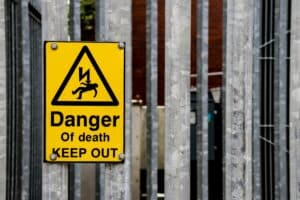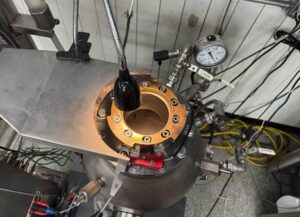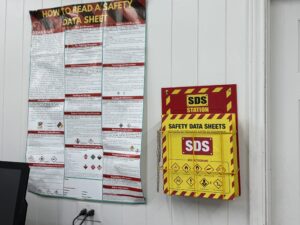We also offer
What is Volume Resistivity Testing
Electrical volume resistivity indicates how much a material resists electrical current flowing through its volume. It specifically refers to the resistance measured across opposite faces of a 1m³ cube of the material. This property plays a key role in determining how easily current moves through a substance and helps predict low-frequency dielectric breakdown and dissipation factor behavior.
Materials with high volume resistivity, such as insulators, strongly resist current flow. In contrast, conductive materials with low resistivity allow current to pass through more easily. Several factors, including a material’s composition, structure, and temperature, directly influence its volume resistivity.
Testing Principle and Methodology
The test setup consists of two rectangular electrodes with:
-
Surface area A
-
Distance between electrodes D (or material thickness)
The volume resistivity (ρ) is calculated using:
Where:
-
ρ = volume resistivity (Ω·m)
-
R = resistance (Ω)
-
A = electrode surface area (m²)
-
D = distance between electrodes (m)
Procedure:
-
Apply a DC voltage to one electrode.
-
Measure current through the sample to determine resistance R.
-
Use the above formula with measured dimensions to calculate volume resistivity.
-
Alternatively, use a megger-ohmmeter for direct resistance measurement.
Environmental Factors: Testing is typically conducted under various humidity conditions, and samples are tested as received in their commercial form. If unsure about the setup, contact Prime Process Safety Center for guidance.
Applicable Standards
Volume resistivity testing is conducted according to:
-
ASTM D257 – Standard Test Methods for DC Resistance or Conductance of Insulating Materials
-
BS 5958: Part 1: 1991
-
BS 7506: Part 2: 1996
-
EN ISO/IEC 80079-20-2
-
NFPA 77
Equipment Used:
-
ANKO Volume Resistivity Test Cell
Data Interpretation
Volume resistivity values are interpreted as follows:
| <105 | Conductive / Low Resistivity |
| 105 to 109 | Static Dissipative / Medium Resistivity |
| >109 | Non-Conductive / High Resistivity |
Knowing your material’s resistivity allows you to apply appropriate safety measures—such as using earthed containers, hoppers, and silos—to prevent charge build-up and spark discharges in flammable environments. Understanding electrostatic properties is critical to safe handling and storage.
When to Perform Volume Resistivity
Perform volume resistivity testing when handling bulk materials prone to electrostatic charging, such as powders or solids. Generally, materials with higher volume resistivity are more resistive and less conductive, leading to charge accumulation and retention. Conversely, materials with low resistivity or static dissipative properties conduct or dissipate charges more readily. Understanding your material’s volume resistivity helps implement proper safety measures to prevent electrostatic discharge hazards.
Why Choose Prime Process Safety Center
Prime Process Safety Center is a leader in process safety testing with highly experienced laboratory personnel. Our goal is to provide accurate, reliable, and defensible data that meets industry and regulatory standards. We recognize the importance of quality data and work diligently to ensure it.
- As an ISO/IEC 17025:2017 accredited laboratory, we ensure every test meets the highest standards of competence, impartiality, and technical rigor.
-
Our expertise ensures accurate and reliable volume resistivity test results.
-
We use state-of-the-art volume resistivity testing equipment for precise and sensitive measurements.
-
We adhere to strict testing protocols and quality control measures for consistent and trustworthy results.
-
Our team interprets and analyzes test data to provide valuable insights and recommendations tailored to your application or research.
FAQ
What is Electrical Volume Resistivity?
Answer: Electrical Volume Resistivity, often simply called volume resistivity, refers to the material's inherent property that describes its ability to resist the flow of electrical current through its volume.
How is Electrical Volume Resistivity Measured?
Answer: Volume resistivity is measured by applying a known voltage across a sample of material and measuring the resulting current passing through it. The resistance and dimensions of the sample are used to calculate the resistivity.
Why is Electrical Volume Resistivity Important?
Answer: Volume resistivity of powders and solid materials is crucial in determining a material's suitability for electrical insulation, as well as in assessing its ability to conduct or resist electrical currents in various applications.
What Factors Affect a Material's Volume Resistivity?
Answer: Factors influencing volume resistivity include material composition, purity, temperature, relative humidity, and crystalline structure.
What Materials Typically Have High Volume Resistivity?
Answer: Insulating materials like ceramics, glass, and certain plastics usually exhibit higher volume resistivity values, making them suitable for electrical insulation.
What are the Applications of Volume Resistivity Testing?
Answer: Volume resistivity testing is essential in selecting materials for electrical insulators, cables, semiconductor devices, and other electrical components.
How Does Temperature Affect Volume Resistivity?
Answer: In general, volume resistivity tends to decrease with increasing temperature due to increased thermal agitation and mobility of charge carriers.

















